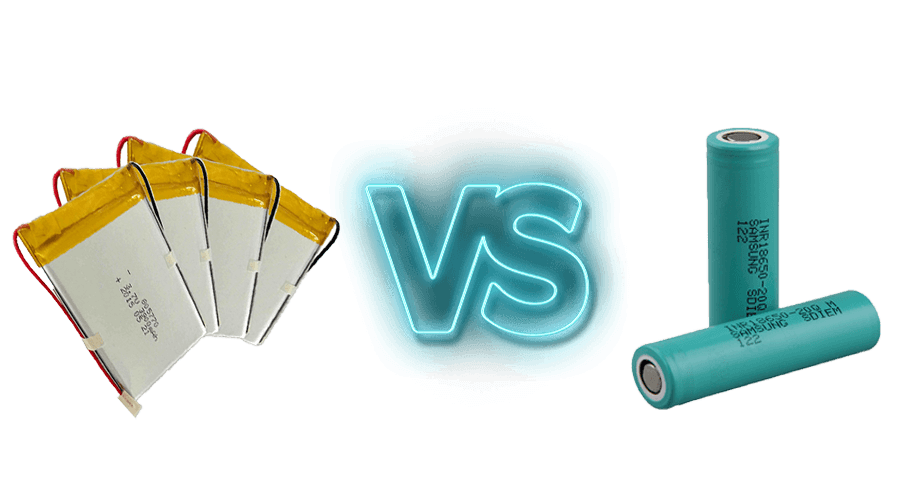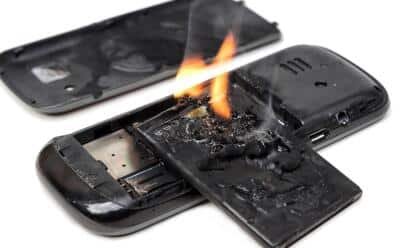What is Lithium Polymer Battery ?
Lithium Polymer Battery, popularly known as LiPo Battery, works on the lithium-ion technology instead of the normally used liquid electrolyte. These kinds of batteries are rechargeable thereby providing users with huge savings in terms of cost.
Such batteries are specifically used on products and appliances where weight is a crucial feature, as in, where already weight is a special consideration. For example, consumers prefer light weighted mobile phones so mobile companies have to use such batteries that do not add to the weight of the phones.
So, what’s the big deal about these batteries?
I’ll explain. Such batteries are gaining more and more popularity these days because of their long run time and high power and hence it is of paramount importance that we understand every little detail about them.

History of Lithium Polymer Batteries
Batteries are the first practical way of generating electricity and were invented by Alessandro Volta. Before generators came into the scene, batteries were the main source of electricity till the end of the 19th century.
Every year there was a certain improvement in the battery technology which assured that there was something exceptional to come. Many scientists and engineers developed several commercial important batteries, one of them being the wet cells which were used on a large scale in the telegraph and the telephone systems.
Batteries are the first practical way of generating electricity and were invented by Alessandro Volta. Before generators came into the scene, batteries were the main source of electricity till the end of the The ancient electric cars also used the semi-sealed wet cells. This background of the batteries was the key for the development of the LiPo cells. The discovery of the Lithium Polymer Battery cells came because of the Lithium-ion and lithium-metal cells as they went to depth in the 1980s. A significant, yet remarkable milestone was the first commercial Li-ion cell of Sony in 1991. There was a revolution thereafter which introduced a pouch form of battery called “LiPo”.

Internal Structure of a Lithium Polymer Battery
Lithium Polymer Battery is a combination of a cylindrical and a rectangular shaped structure. The internal structure is bounded spirally that helps in creating a partition between the anode and the cathode portions of the battery by putting a concise and highly porous polyethylene layer between the two.
Also, as explained earlier, Lithium Polymer batteries work on the principle of using liquid electrolyte solution, so a portion of the battery is filled with organic liquid electrolyte solution. Also, to protect the battery from unprecedented incidents such as short circuit or explosions, safety valves, and PTC components are installed.
Followed by these, cells are installed either in a series or parallel to one another. The number of cells varies depending on the total voltage requirement of the battery. The voltage of one cell is 3.6V and the total voltage of the battery is the sum of the voltage of the cells installed.

Advantages and Disadvantages of Lithium Polymer Batteries

Advantages
Use of these batteries provides the manufacturers a competitive advantage over the others. Because, not only are these rechargeable but also, they can be literally produced in any shape and size because of their light weight.
But, remember, the upshot here is that their self-discharge rate, as in the rate at which they are exhausted, irrespective of the quantum of use, is also quite low at around 5% per month.
Disadvantages
Their overall life span is comparatively much shorter (about 500-800 charge cycles), especially when used in high demand applications, ie, high discharge lipo battery(250-500 charge cycles).
Also, because of the complicated and much sensitive chemistry involved, these batteries require special care and attention while storing, charging and discharging throughout their life span.
To say the least, if good and proper care is not taken, then Lithium Polymer Battery can lead to explosions also. Also because of the safety issues, they have been classified as dangerous goods by the shipping companies making their shipping expensive and difficult.
Also, they are quite expensive as compared to the other NiCad and NiMH batteries.
Differences between Li-Ion and Li-Polymer (LiPo) Battery
Based on the composition of ions that carry the electrolyte materials, Lithium Batteries can be classified as Lithium Ion and Lithium Polymer. Following are the points of difference between the two:
- Li-ion batteries use liquid electrolytes whereas LiPo batteries use solid gel like polymers that substitute the electrolytes.
- Li-ion batteries are relatively cheaper because of the higher energy density.
- LiPo Batteries are safer and light weight.
- LiPo Batteries are rechargeable and have a longer span of life once charged as compared to the Li-ion batteries which tend to lose charge even when not in use.

Differences between LiPo Battery and NiMH Battery

The major point of differences between the LiPo and NiMH batteries are:
- The chemical properties and the composition of both the batteries. On one hand, where Nickel Metal Hybrid (NiMH) batteries use technology based on nickel, on the other hand, LiPo batteries use lithium technology.
- As discussed earlier, batteries differ depending on their voltage and capacities which in turn is determined by the battery cells which are either connected in series or parallel to one another inside the battery pack.
So, basically, both these properties differ in terms of their capacity and voltage, ultimately resulting in a difference amongst their properties and uses.
NiMH batteries are comparatively easier to use as compared to the LiPo batteries. This is mainly because their chargers are simple and they work on a plain principle where the batteries should be fully charged before they are put to use and similarly, they should be fully discharged before they are put to charging.
On the other hand, LiPo batteries don’t follow this phenomenon. They are not supposed to be fully charged before putting to use. Rather their charge level has to be maintained at a steady level of around 50-70%. The charging is to be supported by balanced charging; a feature which is found only in LiPo compatible chargers.
NiMH batteries can be charged using any charger whereas LiPo batteries should be charged only by the LiPo compatible chargers. Also, the storage and the maintenance of NiMH batteries is easier as compared to LiPo which should be exclusively stored in safe bags at room temperature in order to prevent any mishap from occurring.
All Things You Need to Know about Lithium Polymer Battery
What is C Rating
Just like there is a ranking or grading system present for almost everything, every appliance, every product, and every process, similarly, the batteries are rated as well using a rating system.
The truth is that such a rating system is required to guide us in selecting the most appropriate battery pack depending on our specific needs and the properties the battery possess.
In the case of Lithium Polymer Battery, mainly following ratings need to be checked before deciding whether to buy or not:
What is Discharge (C) Rating
This is the most complicated term amongst all the ratings.
Here’s what it looks like, The discharge rate is the value that allows users to determine how much amps that the battery can continuously output without sustaining damage, it is therefore also a measure of the rate at which battery can be discharged safely that is, without harming the battery.
Many Radio control applications require high amperage, which makes it a crucial factor to know a battery’s discharge rate to ensure a vehicle’s overall performance.
What makes this complicated is that this is not a standalone number like the following two. Rather, it is a calculated figure that takes into account the capacity of the battery as well.
What is Battery Capacity
Capacity, in basic terms, refers to the quantum of power that a battery can hold. Say, for example, a fuel tank’s capacity is measured in terms of the amount of fuel it can hold and how long the vehicle can run before the fuel tank gets completely empty. Similarly, the capacity of a battery is the amount of power it can hold.
It is measured in milliamp hours (mAH).
Stay with me! As a consumer, all you need to know is that mAH is the amount of pressure you can put on the battery that will lead to its complete drainage in one hour. Undoubtedly, higher the number, better the battery as higher the power it can hold and therefore the run time will be higher.


What is Cell Count/Voltage
Before getting into the voltage of the Lithium Polymer Battery, we should know what voltage is?
So, in simple terms, voltage determines how fast the appliance is going to run. Higher the voltage more is the speed and vice-versa. One normal LiPo battery has a nominal voltage (resting voltage of a battery pack) of 3.7V.
Now, if the appliance requires a battery of 7.4V, two LiPo cells will be required in a series. It works on a simple concept that the voltage gets added up as in the voltage of each cell installed in the series will be added up to determine the total voltage of the battery.
In our day to day lives, we often come across terms like ‘2S Battery Pack’, ‘3S Battery Pack’, ‘4S Battery Pack’ etc.
These are nothing but simple terms to understand the combination i.e., 2S refers to 2 cells in a series; 3S refers to 3 cells in a series; 4S refers to 4 cells in a series and so on. This implies that 3S Battery Pack will have a voltage of 11.1V; 4S Battery Pack will have a voltage of 14.8V and so on.
For a further explanation:
The “4S” means it has four cells in a series. Since each cell has 3.7 volts (or 4.2 volts when fully-charged), the battery has a total pack voltage of 14.8 volts or 16.8 volts. The second number, on the other hand, refers to the battery’s capacity in milliamp-hours (mAh). A 2200mAh battery at full charge can provide a current of 2200 milliamps for one hour before it becomes fully discharged.
What is Internal Resistance
As the name suggests, Internal Resistance is the difficulty faced by the battery in discharging its energy due to its own internal factors. Higher the internal resistance higher is the energy lost in terms of heat.
Therefore, needless to say, a high internal resistance is not good for any battery because, it shows that the energy produced by the battery doesn’t reach its required destination, rather it is lost in terms of heat. An important point to note here is that, unlike the above 3, Internal Resistance is not printed on the battery.
This is because Internal Resistance doesn’t stay constant and it changes over the life of the battery and other factors like temperature also have a bearing on it. However, that doesn’t reduce its importance. Internal Resistance is an equally important measure of the battery’s efficiency and must be taken into consideration before taking the final decision of buying the battery.
How do Lithium Polymer Battery Charge and Discharge?

Charging Curve for Lithium polymer battery

Discharging Curve at Different Temperature
It is of paramount importance that LiPo compatible chargers are only used for charging such batteries. As explained before, these batteries require special care and attention to prevent any mishap from occurring.
LiPo batteries use the concept of Constant Current/Constant Voltage (CC/CV) for charging.
Here’s what it looks like, basically as you connect the battery to the charger, initially it will maintain a constant charge rate until the battery reaches its voltage. And once the battery reaches its peak voltage, the voltage will be maintained at that rate and the quantum of current will be reduced slowly and steadily.
Also, Lithium Polymer Battery compatible chargers have a special feature of balancing, that is, not only they charge the battery to its peak, rather they maintain a balance in between the voltage of each cell that has been connected to the series. This contributes in optimum performance of the battery. A lot of balancers are available in the markets, however, it is both economic and efficient to buy a charger that has an in-built balancer and LiPo compatible chargers boast of that feature.
It is very crucial for the user to make sure that the Lithium Polymer batteries are well balanced which means that each cell hooked up in the series is at the same volt of around 3.7 Volts. Similarly, while charging a battery each cell will be charged up from the last voltage reading, it is rested on.
For example, if a 4S pack battery is put into use it will draw more current and the props will also spin at an increased rate.
Why am I showing you all these? The reason is that if one tries to attract more current from a battery beyond its capability, its voltage capacity will drop down soon. It will also lead to destroying chemistry content of the battery which can even reduce the time span of the battery.
There has not been any a case of a LiPo battery bursting into flames while in storage. The fire accidents involving LiPo batteries often happen during the battery’s charge or discharge. The majority of battery problems occur during charging, and the fault usually lies on the charger or the person operating it. This does not always happen, but these are the common factors in most LiPo battery fire cases.
There are lessons to learn from these incidents. First, users must invest in a good quality charger to avoid it being the cause of a fire. Second, the operator of the charger must learn how to operate it properly. An excellent choice of a charger LiPo battery is those with built-in checks. This type of battery charger allows the user to configure it properly.
Discharging
As the runtime of Lithium Polymer Battery is longer and they provide higher power, there is a constant threat of fire and explosion, if the batteries are not used properly. As discussed before, higher internal resistance refers to a higher amount of heat generated. Now, when heat is generated, it is released in the form of oxygen which is a combustible gas thereby leading to fire.
So, it is preferred to keep a track of Internal Resistance reading displayed on the charger, if your charger supports that. However, it is a rare feature and is found only in expensive chargers, not everyone can afford that. Therefore, another simpler way to keep a track of Internal Resistance is to occasionally check the battery.
If the Internal Resistance is more, the battery will swell up a little due to oxygen build up. This is the battery’s way of telling you that its end is near, premature or timely, and it is in your best interest that you discard it.
LiPo battery charging is safe if and only you follow the guidelines and take the necessary precautions. LiPo batteries last for more than hundred cycles before going off, so proper charging and usage is recommended.

Discharging Curve for Lithium Polymer Cell

Storage
One rather strange yet interesting fact about Lithium Polymer Battery is that they should not be stored fully charged because they might get damaged that way. It is optimal that the cells are maintained at room temperature and charged a bit at every run. In previous times, people used to charge the batteries till they were fully charged and then used it till their last bit and then again fully charged them.
This was not the right practice. The right and best practice is to maintain a constant voltage level all the times. This does not damage the battery and helps to use it for the maximum time.
Parallel Vs. Series Charging
People in the world always find ways through which they can complete the task at hand in one shot but looking for shortcuts is not always the best available option. Some people opt to charge six single cell LiPo batteries at the same time concurrently and such chargers are also readily available in the market.
However, that is not the best way to charge the battery. Experts say that parallel battery charging is highly dangerous as it doubles the capacity of the batteries and it is important to maintain the voltage of every individual cell connected in the series.
It is not accepted by the manufacturers also, as the charger at the time of charging the bunch of six cells, monitors the battery as a whole and the individual capacity of all the six cells of the series is not taken care of. If two batteries of exactly the same properties with identical qualities are put to parallel charging, then it is fine.
But looking from consumer’s point of view they would not be able to differentiate in them and replicate those exact conditions which are suitable for charging, as a result of which, there will be a significant increase in the chances of overcharging and thermal runaway of the batteries.
Series charging is, therefore, the better option available of the two methods. Anyone wanting to charge six LiPo batteries of the same capacity at a single shot should opt for this series set-up. Balance charging plays a key role here as they charge each cell up to a safe level. If you have six port chargers then this method is the best one, but again it requires special care as it is complicated to set them properly which any casual consumer or a beginner could not handle. This can only be done by sophisticated experts.
Which Connectors are Commonly Used for Lithium Polymer Battery?
LiPo Battery Common Connectors
- Traxxas Connector
The most attractive feature of these connectors is that they are easy to assemble. Also, they can be connected only from one end and are polarity protected from the other end. They are normally used in R/C Cars, trucks and some radio airplanes too.
- Deans Connector
These are the oldest existing conductors and are top favorites of most of the companies. Although a bit difficult to solder, they are well designed and are also polarity protected. They give cut throat competition to Traxxas connectors.
- EC3 Connector
They are the major dominants of the market. Although their assembly is a cumbersome job, still they have a strong foothold in the market.
- Tamiya Connector
They have lost popularity in the current era due to problems such as huge resistance and cumbersome soldering process.
- Venom Connector
These connectors are equipped with adapters which can interface with the above-mentioned connectors, but in reality none of this work properly. People only purchase these because of the standard in all Venom batteries.
- Anderson Power Connector
Having become very rare in the R/C world today, these are not useful to many applications and cover up a huge room.
- JST-XH-Plug
This plug is closest to industry standard plug compared to all others. There are a very few that avoid the use of this plug. It is not as effective as other plugs but it is the cheapest one available for use, outside of China.
- Thunder Power Plug
Even though it is one of the most expensive and effective LiPo packs of the industry, but it is not compatible with around 95% of the chargers in the market. Manufacturers and experts do not always recommend this but they accept the fact that this is a far better option than JST-XH-Plug.

What You Need to Mind about Lithium Polymer Battery
- Never charge or discharge, use or dispose of a damaged LiPo battery. It is always prudent to take such batteries to repair centers or manufacturers so that they can do whatever best can be done to the batteries.
- Avoid purchasing second hand LiPo batteries because the actual condition of such batteries cannot be known exactly.
- Always use a LiPo compatible charger and balancer for charging and discharging. It is of paramount importance that all the cells connected in the series should be balanced at the same voltage level because if the voltage of various cells deviates too much from one another, then the battery may become unstable.

- While charging, discharging and storage, it is advisable to keep safety equipment’s handy always to be well prepared for any fire or explosion. It is almost impossible to predict when the battery is fully charged or when is it discharged, therefore, any mishap cannot be prevented for sure.
- For storage of LiPo batteries, always use fire proof containers.
- In case a LiPo battery has swollen up or has become puffy then it should always be disposed.
- Never leave the LiPo battery unattended while charging.
- Don’t overcharge a LiPo battery.
- Never leave the battery idle for more than 2-3 days after fully charging it.
- LiPo batteries should be stored at room temperature.
How to Dispose Lithium Polymer Battery?
Before disposing the Lithium Polymer Battery, just like any other rational customer, one should make sure that the warranty of the battery has expired and you are not losing on any of the benefits that the companies nowadays provide, like replacement or repair if the batteries die before a specific period of time, which normally varies between 6 months and 1 year.
Following are the disposal measures of a LiPo battery –
- Before disposal, make sure that the battery is discharged as much as it can be. LiPo compatible chargers come with a feature of discharging the battery as well so they can well serve the purpose. However, if you don’t have a charger with a feature of discharging the batteries then the battery can be discharged by running down the appliance while keeping in mind that no harm is done to the appliance and no fire is ignited during the process. It will be in the safest interest to keep safety equipment handy.
- Soak the battery completely in warm salt water for at least 24 hours before disposal. Salt water is an extremely good conductor and it will further help to discharge the battery completely. Ensure that all the wires are submerged completely.
- Check the voltage of the battery after the above two steps. If it is almost negligible that is close to 0.0V then you can dispose of the battery, else it should be soaked in salt water for another 24 hours. The apt way to prepare the salt water solution is to boil the water a bit and then add salt to it and keep on adding salt until no further salt can be dissolved. Basically, this step should be repeated until the desired voltage of 0.0V is reached.
- Finally, when target voltage of 0.0V is achieved, the LiPo batteries are disposed in trash along with other garbage. Unlike, other types of batteries, LiPo batteries are not hazardous to the environment.
Most of the companies these days provide an option of disposing the batteries themselves at the end of the life. So, simply, a customer, after using the battery to the fullest at the end of the warranty period, can simply take the battery to the company and they’ll dispose it off in the safest manner.

Main Takeaway
Given the increasing popularity and benefits of the LiPo Batteries, it is not wrong to say that these batteries are the future and therefore like any prudent consumer/manufacturer it is advisable to know about them well in advance and make a sound decision for buying.
LiPo batteries are considered the best, even in public opinion also, as per the benefits that they allot. People always look for good quality to ensure safety and durability and the LiPo batteries boast of all the required features in it.
The only thing one needs to think of, before purchasing any of these battery components is that they come with a proper power supply cord, good adapter and make sure that they invest a certain amount in fireproof bags to avoid any hazardous turn that the battery may take while charging.
These batteries are preferable as they provide higher specific energy when compared to other subjects of lithium battery types. These batteries have the potential to replace the existing NIHM batteries from general use.
So, what are your views on this? Do let us know in the comments below! Here below is part of our lithium polymer battery. If you are searching for lipo battery for your design, DNK Battery is your great choice!

Prev Article: Elon Musk: 18650 Battery is Out, 21700 Will Be the Future
Next Article: How To Ship Lithium Battery
 Chapter 2
Chapter 2 Chapter 3
Chapter 3 Chapter 4
Chapter 4 Chapter 5
Chapter 5 Chapter 6
Chapter 6 Chapter 7
Chapter 7 Chapter 8
Chapter 8 Chapter 10
Chapter 10























This webpage says “But, remember, the upshot here is that their self-discharge rate, as in the rate at which they are exhausted, irrespective of the quantum of use, is also quite low at around 5% per month.” ! How do you explain the fact that I have over a dozen hobby lipo batteries that were put in a drawer at ~50% charge and they are still at ~50% months later???? At 5% a month, my l batteries should be dead by now!
it’s decideded by the outside temperature and PCM layout, 5% a for general idea.
What would be the material properties for the cells (thermal conductivity, young’s modulus, yield strength and density) for something like a standard 3.7V 3000mAh 105151 LiPo Battery Pack. I’m finding countless pieces of information about its electrical output but not a lot about the physical limitations of the battery.
https://www.amazon.com/3000mAh-battery-Rechargeable-Lithium-Connector/dp/B07BTRKD77
please email us for details sales@dnkpower.com
Wonderful information about lithium polymer battery guide, thanks a lot for sharing kind of content with us. Your blog gives the best and the most interesting information. I wonder if we can gather such practical information about it, a great post definitely to come across.
thank you
Hi, I am curious about long term storage of Li-Pol cells. About their shelf lifetime and proper maintenance to last most. Is there any years limit for their lifetime even if maintained?
lithium-ion batteries are suggested to be stored at around 40% state of charge, if maintened in good state, you can use it up to 5-10 years
Is it OK to charge my 1S Lithium Polymer batteries the night before I use them?
it really depends on the charging current of your charger and battery capacity. at 0.2C charging speed, you can charge your lipo battery over the night with rest assured.
Some EV manufacturers say they use lithium ion batteries, some say lithium polymer batteries. Would a car using lithium polymer batteries be more prone to fire while charging than the lithium ion battery. When “they say lithium ion ” are they really using lipos ?
it’s lithium, for battery used for EV, people don’t use the term lipo, they use pouch cell instead, as they are big one, however, there is no such reports of pouch cell will be more easier to catch fire.
Need to know what specs I should look for I need to purchase an adapter for a USB cord that fits a Kodak SMILE Insta Print Digital Camera that has a built in lithium-polymer battery. Don’t know where to find voltage, but was told i need at least 2 amp. The only other spec i see is 700mAh. The usb cord the camera comes with only accommodates usb and I’m not sure this young teen has access to the internet. (It’s a project angel tree gift…which mean the family isn’t well off). I’d like to find an adapter she that fits the usb cord so that she’s able to use the camera on Christmas Day if she doesn’t have internet access Hope you can offer some guidance here.
please let us know the model number of the kodak camera, and we can check here, for such usb adapter, make sure the voltaga and charging current is correct.